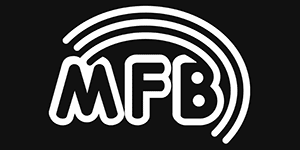
MFB (Manfred Fricke Berlin) company was founded by engineer Manfred Fricke in 1976. Since the beginning of its foundation Fricke's small office has been engaged not in the development of musical instruments but in the sale of a variety of products, for example, video games such as Pong for gaming machines and video equipment. However, he began to dive deep into music production since 1979, when such successful brands as Korg, Roland and Yamaha already shined bright with their products on the market of musical instruments.
The first product which earned big respect was the drum machine MFB-501 released in 1979. The low cost of the instrument made the unit a boom bargain among musicians. Some German stores sold 10 times more of MFB-501 than of Roland TR-808 devices. MFB-501 included ten analog high quality sounds and 64 presets of different music genres featuring no programming possibility. The absence of this function, of course, limited the capabilities of the instrument (to create its own drums, the user needed a completely different product), but the sounds of MFB-501 had a special retro feel. MFB-501 allowed a user to connect it to other music equipment, thereby expanding its capabilities. There is a stereo output, as well as an input/output for the trigger and a pedal switch. The instrument interface included 6 LED backlit switches allowing you to select the available patterns, manage the settings and create something new.
Company’s next version - a completely digital drum machine MFB-512 – inherited all the possibilities from its predecessor. The model included an increased number of patterns (128) with the programming possibility, 8 instrument voices, mono-, stereo-outputs and 8 separate inputs. MFB-512 comprised basic sequencer capabilities and enabled loop function. Despite its capabilities and high efficiency the instrument remained affordable for customers of different categories.
In 1984 E-Drum series modules (1000 and 2000) were released.
In 1986 the company opened the new page in its history with MIDI-CV converter MFB-201 and MIDI-drummer MFB-SYNTH. MFB-SYNTH was developed back in the 80s but was completed only in 1997. In 2001 the machine was discontinued due to the lack of the interest in analog technology on the mass market.
The MIDI interface was followed by the release of MFB-712 which became quite a unique instrument thanks to its MIDI support and 40 recorded drum presets.
When Manfred had produced enough of frame grabbers, in 1994 the company began making the first video mixers: MFB-901, MFB-902 in 1995, MFB-912 (with digital memory capabilities), since 1999 - MFB-915 (inheriting the capabilities from the previous version but featuring a higher quality video and sound), model MFB-920 (with the introduction of the hard drive). MFB mixer series let you discover new possibilities of working not only with sound, but also video, non-linear editing and post-processing.
In 2001 a new MIDI drum module MFB-KULT was released having included the majority of the good sounds generated by the previous machines while MFB-SYNTH series was continued with MFB-SYNTH 1 model, its reduced multifunctional MIDI version SyLITE (MFB-SYNTH LITE) in 2002 , MFB-SYNTH 2 – in 2004. This is a series of monophonic hybrid modular synthesizers with built-in 32-step sequencers and the programming and increasing the number of steps ability. Due to the high demand for MFB-601 digital sequencer MFB-602 was released in May.
Today in addition to a number of Eurorack modules the company produces synthesizers Tanzbär, Tanzbär Lite, Tanzmaus and Dominion-1 keyboard - Dominion X successor.
Dominion-1 is a paraphonic programmable analog synthesizer featuring a velocity sensitive 3-octave keyboard, 3 VCO with synchronization capability, an analog and digital ring modulator, 3 low-frequency oscillators and a 12-mode filter. VCO3 can modulate the frequency of the first and second oscillators as well as dynamically control the LFO or AD envelope. The processor-controlled analog circuit behaves obediently.
Tanzbär is an analogue drum computer with 14 percussion options, as well as synth sounds of bass and melodic voices. Tanzbär is suitable for live performances, as its step sequencer storing up to 144 patterns allows the instant access to them during playback; you can also chain samples applying any possible variations. Sequences of different instruments can be altered individually enabling the creation of polyrhythmic structures. The CV/Gate sequencer can be programmed in two ways. All parameters have a MIDI output allowing control of external instruments. A drum computer can be synchronized with MIDI and clock signals. Master-volume knob controls the value of each instrument individually.
The Tanzmaus replaced MFB 503 offering 5 analog instruments and 2 sample sections with 16 12-bit samples. The sequencer pays attention to the length of each instrumental piece individually and offers a chain mode up to 16 rhythm patterns; Global quantize function, flam function; 5 LFOs; 64 memory patterns - only half of the specs powerful Tanzmaus features.
Tanzbär Lite is presented as a MFB 522 follower with 9 analog instruments inside - the other properties are quite similar to Tanzmaus ones.
Musical equipment MFB has established itself as a manufacturer of the devices with a user-friendly interface and optimal price giving more chances to musicians of different levels.

